Lessico
Verbascum thapsus
Verbasco - Tasso barbasso - Barbasso
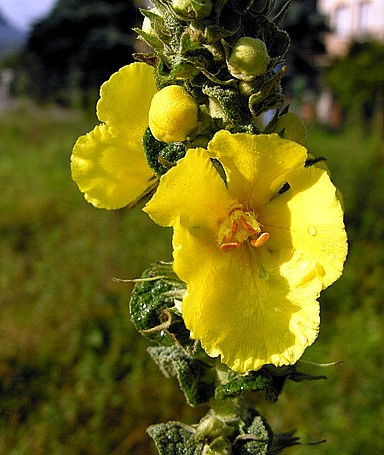
Tasso
barbasso,Verbasco a grandi fiori, Guaragnasco maggiore, Candela regia, Pan
delle serpi, Piantadomine. Il nome del genere è quello usato da Plinio![]() (per es.
in xxv, 108: Est
similis verbasco herba) e forse
deriva dal latino barbascum che significa barbato, con riferimento alla
diffusa pelosità di queste piante.
(per es.
in xxv, 108: Est
similis verbasco herba) e forse
deriva dal latino barbascum che significa barbato, con riferimento alla
diffusa pelosità di queste piante.
Pianta erbacea bienne delle Scrophulariaceae, di aspetto molto variabile, il colore bianco-giallastro è dovuto allo strato di peli argentei, raggruppati in ciuffi appiattiti che la ricoprono, i fusti sono eretti, rigidi, talvolta ramosi, alta sino a 120 cm.
La sua radice affusolata, e cilindrica produce il primo anno una rosetta basale costituita da grandi foglie, sino a 45 cm, obovate, molli, molto tomentose, grossolanamente crenato-dentate, che si assottigliano in picciolo alla base. La rosetta basale dura nell’inverno e produce nel secondo anno un fusto alto e robusto coperto di foglie oblunghe e lanceolate, appuntite all’estremità, decorrenti alla base e formanti delle larghe ali.
I fiori sono raggruppati in fascetti di 6-7 elementi all’ascella e formano una lunga spiga apicale, sono di color giallo di 2 cm di diametro, la corolla è gamopetala leggermente chiusa a imbuto; 5 stami: i filamenti dei 2 inferiori sono glabri nella subsp. thapsus, ma villosi nella subsp. crassifolium (Lam. et DC.) Murb, mentre quelli dei 3 superiori sono bianchi e vellutati. I fiori vivono soltanto un giorno e sono costantemente sostituiti da nuovi elementi. I frutti sono capsule brune a 2 alveoli, contenenti numerosi piccoli semi neri. Attenzione, sono tossici.
Distribuzione in Italia: presente in tutto il territorio, isole comprese, sino a 1.700 m. Habitat: incolti, bordi stradali, campi, ambienti ruderali; pianta che tollera una vasta gamma di condizioni, compresi i terreni aridi e sassosi.
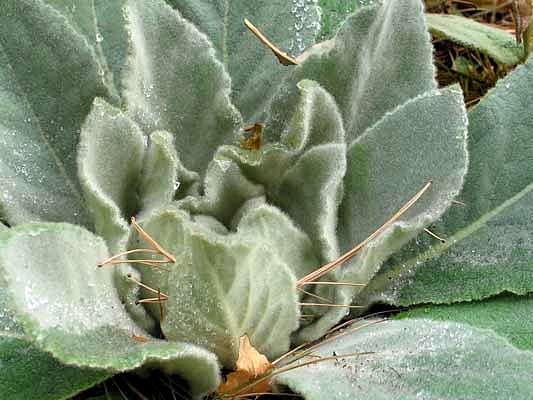
Vengono descritte in Flora d'Italia di Pignatti, due sottospecie:
la subsp. thapsus che è il tipo più diffuso, con foglie basali sessili o quasi, corolla concava con lobi arrotondati e stami inferiori con filamento glabro;
la subsp. crassifolium (Lam. et DC.) Murb. = V. montanum Schrader, che ha foglie basali con picciolo allungato, foglie cauline non o poco decorrenti, corolla concava spianata con lobi ovati, stami inferiori con filamento sempre villoso, diffusa nel Nord dell'Italia fino alla Liguria, Alpi Apuane e Appennino Settentrionale fino al Pistoiese.
Specie simili sono il Verbascum densiflorum Bertol. - “Falso barbasso”, con fiori peduncolati e corolle rotate piatte e il Verbascum phlomoides L. - "Verbasco barbarastio", di maggiori dimensioni e con fiori con diametro sino a 5 cm.
Erba amara, rinfrescante, mucillaginosa, decongestionante, espettorante, antisettica, diuretica, analgesica. È un ottimo rimedio per tutte le patologie caratterizzate da abbondante secrezione mucosa. Il glucoside più attivo contenuto nella pianta è il verbascoside, che esercita la sua azione fluidificando le secrezioni e riducendo i fenomeni infiammatori a livello delle vie respiratorie superiori e inferiori. Per uso interno in caso di tosse, catarro, pertosse, bronchite, laringite, infezioni del tratto urinario e diarree.
Per uso esterno le foglie vengono utilizzate per decotti detergenti su piaghe e ferite, per cataplasmi su foruncoli, scottature, emorroidi e geloni.
Pianta che per il suo aspetto a candelabro è spesso coltivata come ornamentale è inoltre buona mellifera. Già in epoca classica, alcune specie di Verbascum venivano impiegate a scopo medicinale per i disturbi respiratori, anche se non si conosce con certezza quali fossero.
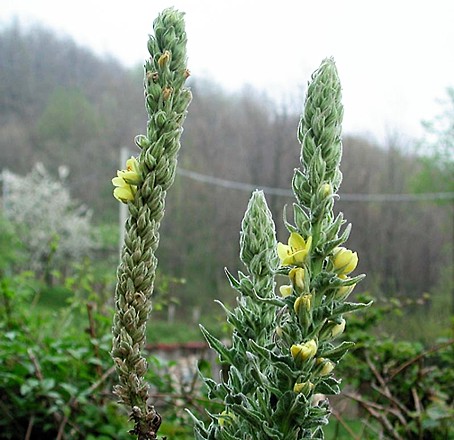
www.funghiitaliani.it
Great
Mullein
or Common Mullein
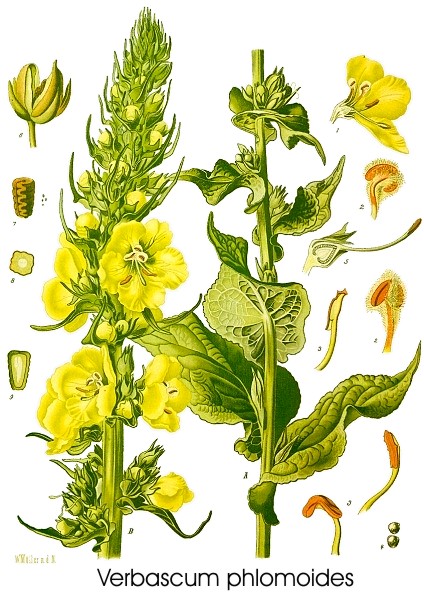
Verbascum thapsus (Great Mullein or Common Mullein) is a species of mullein native to Europe, northern Africa and Asia, and introduced in the Americas and Australia. It is a hairy biennial plant that can grow to 2 m or more tall. Its small yellow flowers are densely grouped on the tall stem, which bolts from a large rosette of leaves.
It grows in a wide variety of habitats, but prefers well-lit disturbed soils, where it can appear soon after the ground receives light, from long-lived seeds that persist in the soil seed bank. It is a common weedy plant that spreads by prolifically producing seeds, but rarely becomes aggressively invasive since its seed require open ground to germinate. It is a very minor problem for most agricultural crops since it is not a very competitive species, being intolerant of shade from other plants and unable to survive tilling. It also hosts many insects, some of which can be harmful to other plants. Although individuals are easy to remove by hand, populations are difficult to eliminate permanently.
It is widely used for herbal remedies with emollient and astringent properties. It is especially recommended for coughs and related problems, but also used in topical applications against a variety of skin problems. The plant was also used to make dyes and torches.
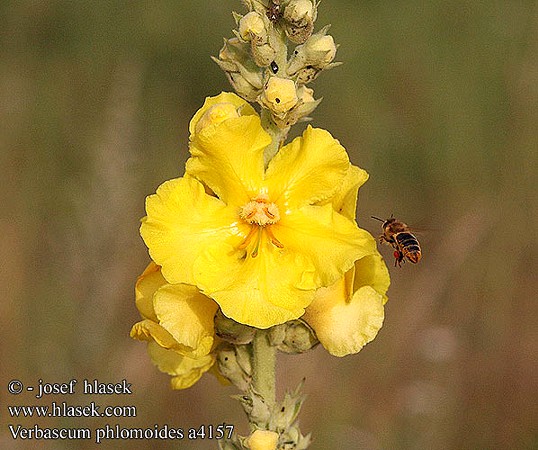
Description
Verbascum thapsus is a dicotyledonous biennial that produces a rosette of leaves in its first year of growth. The leaves are large, up to 50 cm long, and are covered with woolly, silvery hairs. The second year plants normally produce a single unbranched stem 1–2 m tall, with some plants reportedly having stems reaching up to 3.5 m tall. In the east of its range in China, it is however only reported to 1.5 m tall. The tall pole-like stems end in a dense spike of flowers, that can occupy up to half the stem length. All parts of the plants are covered with star-shaped trichomes. Its chromosome number is 2n = 36.
On flowering plants the leaves are alternately arranged up the stem. The leaves are thick, and decurrent on the stem, with much variation especially between the upper and lower leaves on the stem, with leaf shape ranging from between oblong to oblanceolate and ranging in size up to 50 cm long and 14 cm across (19 inches long and 5 inches wide). They become smaller higher up the stem, and less strongly decurrent lower down the stem. The flowering stem is solid and 2–2.5 cm (nearly an inch) across, and occasionally branched just below the inflorescence, usually when damaged. After flowering and seed release the stem and fruits usually persist in winter after drying into hard, stiff structures topped with densely packed, ovoid shaped, dry seed capsules. The dried stems are most often dark brownish, and often persist standing until the next spring or even into the next summer. The plants produce a shallow taproot.
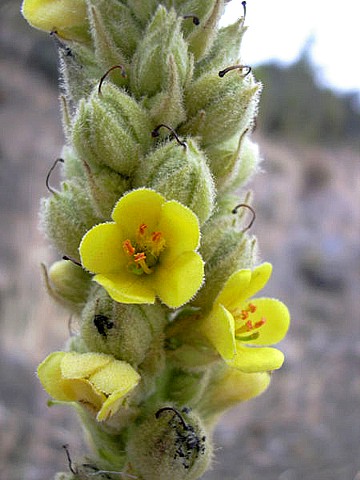
The flowers are pentamerous with five stamen that are fused to the petals and a 5-lobed calyx tube and a 5-petalled corolla, the latter bright yellow and an 1.5–3 cm (0.5–1 inch) wide. The flowers are almost sessile, with very short pedicels (2 mm, 0.08 in). The five stamens are of two types, with the three upper stamens being shorter, with filaments covered by yellow or whitish hairs, and having smaller anthers, while the lower two stamens have glabrous filaments and larger anthers. The plant produces small ovoid (6 mm, 0.24 in) capsules that split open by way of two valves, each capsule containing large numbers of minute brown seeds less than a millimetre (0.04 in) in size, with longitudinal ridges. A white-flowered form V. thapsus f. candicans occurs. Flowering lasts for up to three months from early to late summer (June to August in northern Europe), with flowering starting at the bottom of the spike and progressing irregularly up the spike with each flower open for part of a day with only a few flowers open at the same time produced around the stem.
Distribution and introduction
Verbascum thapsus has a wide native range including Europe, northern Africa and Asia, from the Azores and Canary Islands east to western China, north to the British Isles, Scandinavia and Siberia, and south to the Himalayas. In northern Europe, it grows from sea level up to 1,850 m altitude, while in China it grows at 1,400-3,200 m altitude.
It has been introduced throughout the temperate world, and is established as a weed in Australia, New Zealand, tropical Asia, La Réunion, North America, Hawaii, Chile, Hispaniola and Argentina. It has also been reported in Japan.
In the United States it was imported very early in the 18th century and cultivated for its medicinal and piscicide property. By 1818, it had begun spreading so much that Amos Eaton thought it was a native plant. In 1839 it was already reported in Michigan and in 1876, in California. It is now found commonly in all the states. In Canada, it most common in Southern Quebec, Ontario and British Columbia, and in the Maritime Provinces, with scattered populations in between.
Taxonomy and nomenclature
For the purpose of botanical nomenclature, Verbascum thapsus was first described by Carolus Linnaeus in his 1753 Species Plantarum. The specific epithet thapsus had been first used by Theophrastus (as thapsos) for an unspecified herb from the Ancient Greek settlement of Thapsos, near modern Syracuse, Sicily, though it is often assimilated to the ancient Tunisian city of Thapsus. Within Verbascum, it classified under section Bothrosperma subsect. Fasciculata.
At the time, no type specimen was specified, as the practice only appeared later, in the 19th century. When a lectotype (type selected amongst original material) was designated, it was assigned to specimen 242.1 of Linnaeus' herbarium, the only V. thapsus specimen. The species had previously been designated as type species for Verbascum. European plants exhibit considerable phenotypical variation, which has led to the plant acquiring many synonyms over the years. Introduced American populations show much less variation.
Common names
Verbascum thapsus is known by a variety of names. The standard English name used by authorities in its native area is Great Mullein. In North America, "Common mullein" is the usual name. In the 19th century it had well over 40 different common names in English alone. Some of the more whimsical ones included "Hig candlewick", "Bullicks lungwort", "Adams-rod", "Feltwort", "Hare's-beard" and "Ice-leaf". Vernacular names include innumerable references to the plant's hairiness: "Woolly", "Velvet" or "Blanket Mullein","Beggar's", "Moses'", "Poor Man's", "Our Lady's" or "Old Man's Blanket", and so on ("Flannel" is another common generic name).
Some names refer to the plant's size and shape: "Shepherd's Club(s)" or "Staff", "Aaron's Rod" (a name it shares with a number of other plants with tall, yellow inflorescences), and a plethora of other "X's Staff" and "X's Rod". The name "Velvet" or "Mullein Dock" is also recorded, where "dock" is a British name applied to any broad-leaved plant.
Ecology
Great Mullein most frequently grows as a colonist of bare and disturbed soil, usually on sandy or chalky soils. This is in part due to its intolerance of shade and the very long periods during which the seeds can remain dormant before germination. It is not an agricultural weed, although its presence can be very difficult to completely eradicate, and is especially problematic in overgrazed pastures. The species is considered a noxious weed in Colorado, United States (Class C), Hawaii and Victoria, Australia (regionally prohibited in the West Gippsland region, and regionally controlled in several others).
It grows best in dry, sandy or gravelly soils, although it can grow in a variety of habitats, including banksides, meadows, roadsides, forest clearings and pastures. It germinates almost solely in bare soil, at temperatures between 10 °C and 40 °C. This ability to grow in a wide range of habitats has been linked to strong phenotype variation rather than adaptation capacities. While it can germinate in total darkness if proper conditions are present (tests give a 35% germination rate under ideal conditions), in the wild, it will only do so if the seeds are exposed, or very close to the soil surface. While it can also appear in areas where some vegetation exist, growth of the rosettes on bare soil is four to seven times more rapid.
Megachilidae bees, notably Anthidium species, use the hair in making their nests. The seeds are generally too small for birds to feed on, although the American Goldfinch has been reported to consume them. Other bird species have been reported to consume the leaves (Hawaiian Goose) or flowers (Palila) of V. thapsus, or to use the plant as a source when foraging for insects (White-headed Woodpecker).
Life cycle
Great Mullein is a biennial and generally requires winter dormancy before it can flower. This dormancy is linked to starch degradation in the root activated by low temperatures, and gibberellin application bypasses this requirement. Seeds germinate in spring and summer most often when exposed to light, those that germinate in autumn produce plants that overwinter if they are large enough with rosettes less than 15 cm (5.9 in) across dying in winter. After flowering the entire plant usually dies at the end of its second year but some individuals, especially in the northern parts of the range, require a longer growth period and flower in their third year. Under longer growing conditions, some individuals flower in the first year. Triennial individuals were found to produce fewer seeds than biennial and annual ones. While year of flowering and size are linked to the environment, most other characteristics appear to be genetic.
A given flower is open only for a single day, opening before dawn and closing in the afternoon. Flowers are autogamous and protogynous, with female parts maturating first, and will self-pollinate if they have not been pollinated by insects during the day. While many insects visit the flowers, only some bees actually accomplish pollination. V. thapsus' flowering period lasts from June to August in most of its range, extending to September or October in warmer climates. Visitors include halictid bees and hoverflies. The hair on lower stamens may serve to provide footholds for visitors.
The seeds maintain their germinative powers for decades, up to a hundred years, according to some studies. Because of this, and because the plant is an extremely prolific seed bearer (each plant produces hundreds of capsules, each containing up to 700+ seeds, with a total up to 180,000 or 240,000 seeds), it remains in the soil seed bank for extended periods of time, and can sprout from apparently bare ground, or shortly after forest fires long after previous plants have died. Its population pattern is typically an ephemeral adult population and long periods of dormancy as seeds. Great Mullein rarely establishes on new grounds without human intervention because its seeds are not dispersed very far. Seed dispersion requires the stem to be moved by wind or animal movement; 75% of the seeds fall within 1 m of the parent plant, and 93% fall within 5 m.
Agricultural impacts and control
Great Mullein is no longer considered a serious agricultural weed because it cannot compete with established plants, and is easily crowded out in cultivation, except in areas where vegetation is sparse to begin with, such as Californian semi-desert areas of the Eastern Sierra Nevada. In such ecological contexts, it crowds out native herbs and grasses. Its tendency to appear after forest fires also disturbs the normal ecological succession. In the past, when fields were hand cultivated, it was a serious pest species and called a troublesome weed.
Despite not being an agricultural weed in itself, it hosts a number of insects and diseases, including both pests and beneficial insects. It is also a potential reservoir of the cucumber mosaic virus, powdery mildew (Erysiphum cichoraceum) and Texas root rot. A study found V. thapsus hosts insects from 29 different families. Most of the pests found were western flower thrips (Frankliniella occidentalis), Lygus species such as the tarnished plant bug (L. lineolaris), and various spider mites from the family Tetranychidae. These make the plant a potential reservoir for overwintering pests.
Other insects commonly found on Great Mullein feed exclusively on Verbascum species in general or V. thapsus in particular. They include mullein thrips (Haplothrips verbasci), Gymnaetron tetrum and the Mullein Moth (Cucullia verbasci). Useful insects are also hosted by Great Mullein, including predatory mites of the Galendromus, Typhlodromus and Amblyseius genera (Phytoseiidae), the minute pirate bug (Orius tristicolor) and the mullein plant bug (Campylomma verbasci). The plant's ability to host both pests and beneficials makes it potentially useful to maintain stable populations of insects used for biological control in other cultures, like Campylomma verbasci and Dicyphus hesperus (Miridae), a predator of whiteflies. A number of pest Lepidoptera species, including the Stalk Borer (Papaipema nebris) and Gray Hairstreak (Strymon melinus), also use V. thapsus as a host plant.
Control of the plant, when desired, is best managed via mechanical means, such as hand pulling and hoeing, preferably followed by sowing of native plants. Animals rarely graze it because of its irritating hairs, and liquid herbicides require surfactants to be effective, as the hair causes water to roll off the plant, much like the lotus effect. Burning is ineffective, as it only creates new bare areas for seedlings to occupy. G. tetrum and Cucullia verbasci usually have little effect on V. thapsus populations. Goats and chickens have been proposed to control Mullein. Effective (when used with a surfactant) contact herbicides include glyphosate, triclopyr and sulfurometuron-methyl. Ground herbicides, like tebuthiuron, are also effective, but recreate bare ground and require repeated application to prevent regrowth.
Uses
Great Mullein has been used since ancient times as a remedy for skin, throat and breathing ailments. It has long had a medicinal reputation, especially as an astringent and emollient. It contains mucilage, several saponins, coumarin and glycosides. Dioscorides recommended it for diseases of the lung and it is nowadays widely available in health and herbal stores. Non-medical uses have included dyeing and making torches.
Medical uses
Dioscorides first recommended the plant 2000 years ago, against pulmonary diseases, and this has remained one of its primary uses, especially against cough. Leaf decoctions or herbal teas were used for expectoration, consumption, dry cough, bronchitis, sore throat and hemorrhoids. Leaves were also smoked against pulmonary ailments, a tradition that in America was rapidly transmitted to Native American peoples. They used the non-indigenous plant to make syrups against croup. The combination of expectorant saponins and emollient mucilage makes the plant particularly effective for cough. All preparations meant to be drunk have to be finely filtered to eliminate the irritating hairs.
Oil from the flowers was used against catarrhs, colics and, in Germany, earaches, frostbite, eczema and other external conditions. Topical application of various V. thapsus-based preparations was recommended for the treatment of warts, boils, carbuncles, hemorrhoids, and chilblains, amongst others. Recent studies have found that Great Mullein contains glycyrrhizin compounds with bactericide and potential anti-tumoral action. These compounds are concentrated in the flowers. Different extracts have varying levels of efficiency against bacterias. In Germany, a governmental commission sanctioned medicinal use of the plant for catarrhs. It was also part of the National Formulary in the United States and United Kingdom. The plant's leaves, in addition to the seeds, have been reported to contain rotenone, although quantities are unknown.
In Spanish, Great Mullein is called Gordolobo. Gnaphalium conoideum was used in a fashion similar to Mullein by the Mexican Aztecs, which caused confusion in naming, and both are sold under the name "Gordolobo", (although V. thapsus is not found in Mexico). This situation has led to at least one case of poisoning due to confusion of G. conoideum with Senecio longilobus.
Other uses
Like many ancient medicinal plants (Pliny the Elder describes it in his Naturalis Historia), Great Mullein was linked to witches, although the relationship remained generally ambiguous, and the plant was also widely held to ward off curses and evil spirits. The seeds contain several compounds (saponins, glycosides, coumarin, rotenone) that cause breathing problems in fish, and have been widely used as piscicide for fishing.
The flowers provide dyes of bright yellow or green, and have been used for hair dye. The dried leaves and hair were made into candle wicks, or put into shoes to help with insulating them. The dried stems were also dipped into suet or wax to make torches. For obvious reasons, the plant, unlike other species of the genus, is not often cultivated.